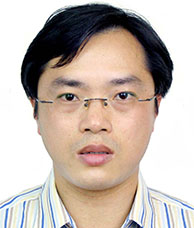
报告时间:4月12日(周三)下午2:30
报告地点:蒙民伟楼2楼201学术报告厅
报告人:黄飞鹤教授 (浙江大学 )
报告题目:Supramolecular Polymers Based on Host-Guest Molecular Recognition Motifs (基于主客体分子识别构筑超分子聚合物)
报告人简介:
1973年出生。1996年7月本科毕业于合肥工业大学。1999年7月获得中国科技大学高分子化学与物理硕士学位。2005年3月获弗吉尼亚理工大学有机与高分子化学博士学位。后在University of Utah化学系从事博士后工作。2005年12月起任浙江大学化学系教授。主要从事超分子化学方面的研究工作,2003年至今已在国际核心化学期刊上发表超分子化学相关SCI论文200篇,包括4篇Accounts of Chemical Research、2篇Chemical Reviews、5篇Chemical Society Reviews、1篇Progress in Polymer Science、1篇Nature Chemistry、3篇PNAS、25篇Journal of the American Chemical Society、5篇Angewandte Chemie International Edition、7篇Advanced Materials、和1篇Nature Communications。发表的论文已被引用14458次,h-index为67。两篇通讯作者论文入选“中国百篇最具影响国际学术论文”。到目前为止获得的主要奖励有:2007年获美国李氏基金会杰出成就奖,2011年获得国家杰出青年科学基金项目资助,指导博士生获得2011年全国百篇优秀博士论文提名奖,2012年入选英国皇家化学会会士(Fellow of the Royal Society of Chemistry, FRSC),2013年入选国家创新人才推进计划中青年科技创新领军人才,2013年入选亚洲化学大会Asian Rising Star,2013年获得浙江省青年科技奖,2014年获中国化学会-阿克苏诺贝尔化学奖,2015 年获英国皇家化学会Cram Lehn Pedersen Prize in Supramolecular Chemistry,2016 年获英国皇家化学会Polymer Chemistry Lectureship Award,2016年入选国家万人计划领军人才。应邀在国内外作学术报告100次,包括应邀到澳大利亚全国高分子会议上作学术报告,应邀在全国有机化学学术讨论会上作大会报告,应邀到第15届亚洲化学大会上作Asian Rising Stars分会邀请报告,应邀到韩国全国高分子会议上作学术报告,应邀在全国大环化学暨超分子化学学术讨论会上作大会报告,应邀在美国举行的第一届人工分子开关与马达高登会议(Gordon Research Conference)上作邀请报告,应邀在法国举行的第十届大环与超分子化学国际研讨会(ISMSC-10)上作大会报告,应邀在澳大利亚举行的第23届IUPAC国际物理有机化学会议上作大会报告。应邀担任Chemical Society Reviews、Accounts of Chemical Research、Chemical Reviews、Chemical Communications、和Advanced Materials的客座编辑。应邀担任Chemical Society Reviews(2012年起)、Chemical Communications(2012年起)、化学学报(2012年起)、Macromolecules (2014年-2017年)、ACS Macro Letters(2014年-2017年)、Polymer Chemistry(2014年起)、Materials Chemistry Frontiers(2016年起)、高分子学报(2016年起)等的顾问编委或编委。
Supramolecular Polymers Based on Host-Guest Molecular Recognition Motifs
Feihe Huang*
Department of Chemistry, Zhejiang University, Hangzhou 310027,
China
e-mail: fhuang@zju.edu.cn
http://www.chem.zju.edu.cn/~huangfeihe/index.php
Supramolecular
polymers, assembled from low molecular weight monomers via noncovalent interactions, such as hydrogen bonding, metal
coordination as well as host-guest interactions, have demonstrated traditional
polymeric properties and become an important source for the development of
stimuli-responsive dynamic materials. We are interested in the fabrication of
supramolecular polymers based on host-guest molecular recognition motifs. Self-sorting
organization of two AB–type heteroditopic monomers led to the formation of linear supramolecular alternating
copolymers driven by host-guest noncovalent interactions based on the bis(p-phenylene)-34-crown-10/paraquat
derivative and dibenzo-24-crown-8/dibenzylammonium salt recognition motifs. By utilization
of host-guest and metal-ligand noncovalent recognitions motifs, different topologies of supramolecular polymers, such as linear
and crosslinked species, can be reversibly interconverted by external stimuli. Based on the dibenzo-24-crown-8/1,2-bis(pyridinium)ethane
recognition motif, a hyperbranched mechanically interlocked polymer was
prepared by polyesterification of an easily available dynamic trifunctional AB2 pseudorotaxane monomer. By utilization of a crown ether-based host-guest recognitions
motif, a supramolecular polymer gel constructed from a low molecular weight A-B
monomer shows thermo- and pH-induced
reversible gel-sol transitions. The
thermal- and pH-responsive gel-sol transitions were successfully employed in
the controlled release of Rhodamine B.
References
1. Wang, F.; Han, C.; He, C.; Zhou, Q.; Zhang, J.; Wang, C.;
Li, N.; Huang, F.* J. Am. Chem. Soc. 2008, 130, 11254.
2. Wang, F.; Zhang, J.; Ding, X.; Dong, S.; Liu, M.;
Zheng, B.; Li, S.; Zhu, K.; Wu, L.; Yu, Y.; Gibson, H. W.; Huang, F.* Angew.
Chem., Int. Ed. 2010, 49, 1090.
3. Zhang, Z.; Luo, Y.; Chen, J.; Dong, S.; Yu, Y.;
Ma, Z.; Huang, F.* Angew. Chem., Int. Ed. 2011, 50, 1397.
4. Dong, S.; Luo, Y.; Yan, X.; Zheng, B.; Ding, X.;
Yu, Y.; Ma, Z.; Zhao, Q.; Huang, F.* Angew. Chem., Int. Ed. 2011, 50, 1905.
5. Yan, X.; Xu, D.; Chi, X.; Chen, J.; Dong, S.; Ding, X.;
Yu, Y.; Huang, F.* Adv. Mater. 2012, 24, 362.
6. Dong, S.; Zheng, B.; Xu, D.; Yan, X.; Zhang, M.; Huang,
F.* Adv. Mater. 2012, 24, 3191.
7. Zhang,
M.; Xu, D.; Yan, X.; Chen, J.; Dong, S.; Zheng, B.; Huang,
F.* Angew. Chem., Int. Ed. 2012, 51, 7011.
8. Ji, X.; Yao, Y.; Li, J.; Yan, X.; Huang, F.* J. Am. Chem. Soc. 2013, 135, 74-77.
9. Yan, X.; Li, S.; Pollock, J. B.; Cook, T. R.; Chen,
J.; Zhang, Y.; Ji, X.; Yu, Y.; Huang, F.;* Stang, P. J.* Proc. Natl. Acad. Sci. U. S. A. 2013, 110, 15585-15590.
10. Ji, X.; Dong, S.; Wei, P.; Xia, D.; Huang, F.* Adv. Mater. 2013, 25, 5725-5729.
11. Yan, X.; Li, S.; Cook, T. R.; Ji, X.; Yao, Y.;
Pollock, J. B.; Shi, Y.; Yu, G.; Li, J.; Huang, F.;* Stang, P. J.* J. Am. Chem. Soc. 2013, 135, 14036-14039.
12. Yan, X.; Cook, T. R.; Pollock, J. B.; Wei, P.; Zhang,
Y.; Yu, Y.; Huang, F.;* Stang, P. J.* J. Am. Chem. Soc. 2014, 136, 4460-4463.
13. Yan, X.; Xu, J.-F.; Cook, T. R.; Huang, F.;*
Yang, Q.-Z.;* Tung, C.-H.; Stang, P. J.* Proc.
Natl. Acad. Sci. U.S.A. 2014, 111, 8717-8722.